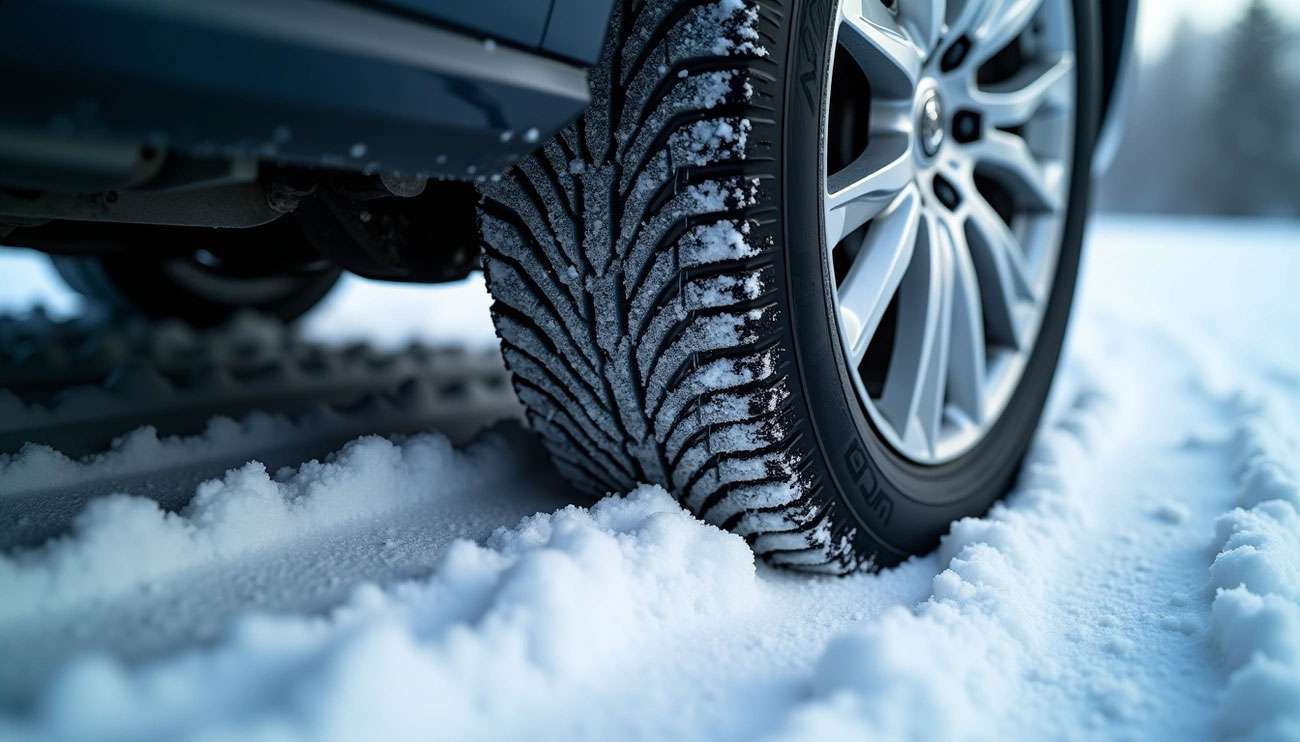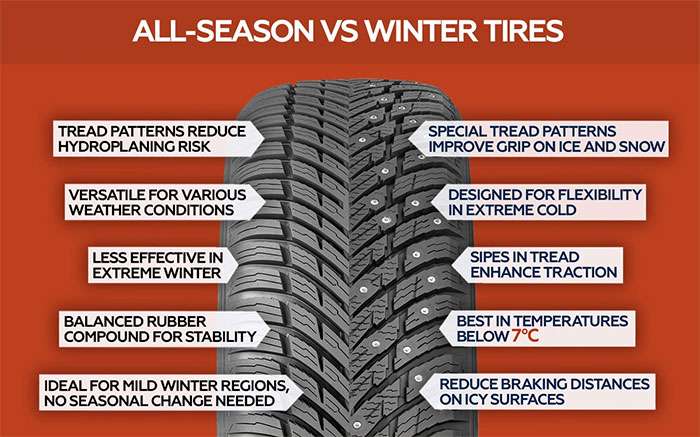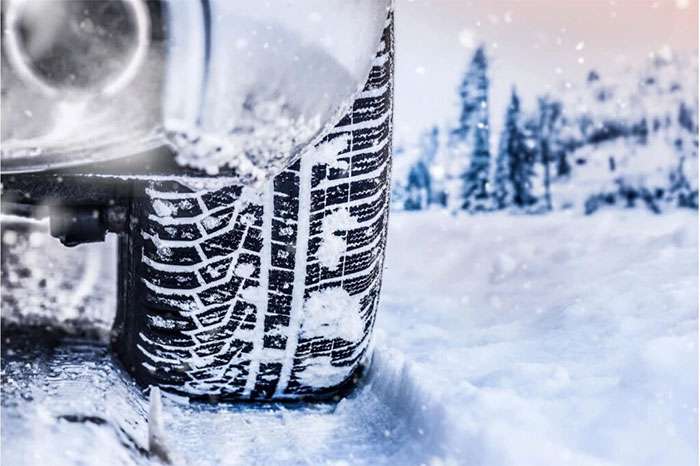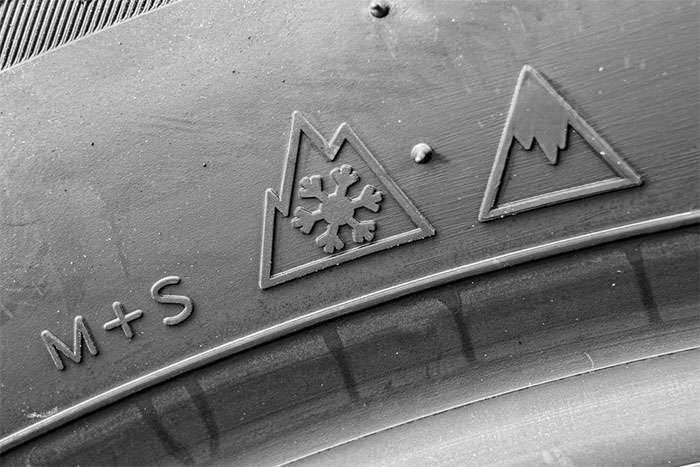
Winter tire technology can reduce your stopping distance by up to 30% on icy roads. This performance advantage makes winter tires essential equipment for drivers who face serious cold-weather conditions. We understand how specialized rubber compounds and smart tread designs work together to keep vehicles safe on dangerous winter roads.
Modern winter tires use advanced silica-infused rubber compounds that stay flexible at extremely low temperatures. This flexibility allows winter tires to maintain grip when all-season tires become rigid and lose effectiveness. Testing by automotive organizations shows that winter tires can reduce stopping distances on ice by up to 50% compared to all-season tires. Winter tires work because their effectiveness comes from fundamental material science, not just aggressive tread patterns.
The 2025 winter tire models incorporate sustainability alongside safety. Electric vehicles have driven development of winter tires with low rolling resistance, while still meeting rigorous standards like the 3-Peak Mountain Snowflake (3PMSF) and additional ice performance criteria. We'll explore the engineering behind these designs, from compound chemistry to tread patterns, and explain why 2025's best winter tire technology delivers the perfect balance of safety, performance, and environmental responsibility.

Image Source: Wheel-Size.com
The chemical composition of a winter tire determines its performance just as much as its tread pattern. Modern winter tire compounds represent a careful balance of materials engineered to remain functional at freezing temperatures where standard tires become dangerously rigid.
Silica has become essential in advanced winter tire technology. This naturally occurring compound, found in materials like quartz and sand, creates remarkable changes in rubber performance. Silica improves tires' grip on wet surfaces by allowing the rubber compound to remain flexible and form stronger bonds with slippery surfaces. It also enhances the tire's ability to respond quickly to steering inputs through improved flexibility and heat dissipation.
The benefits of silica in winter tire compounds include:
Decreased rolling resistance through reduced internal friction between rubber molecules
Enhanced wet surface traction through greater flexibility
Improved heat dissipation properties that maintain optimal performance
Better long-term durability despite challenging conditions
Continental introduced the first winter tire with silica in 1996 with their ContiWinterContact TS 770, marking a significant advancement in cold-weather safety. Since then, silica has become essential in high-performance winter tire formulations. The small silica particles interact with the rubber at a molecular level, creating a more adaptive surface that maintains grip even as temperatures drop.
Natural rubber forms the foundation of most winter tire compounds due to its exceptional elasticity from weak C-H bonds. Harvested as latex from rubber trees and then refined, this organic compound provides the fundamental stretchy properties winter tires require. Natural rubber alone is sensitive to temperature fluctuations and atmospheric oxidation, requiring additional processing through vulcanization to crosslink the polymer chains.
Synthetic rubber—particularly styrene-butadiene rubber—is manufactured by thermally cracking naphtha from petroleum. This material offers greater chemical consistency than natural rubber, making it valuable for precise engineering applications. The 2025 models balance these materials carefully. More natural rubber enhances cold-weather grip, while synthetic components contribute to durability and consistent performance.
Most high-performance winter tires now use multi-compound layers, each serving a specific purpose. Tougher outer layers provide durability against road abrasion, while softer inner layers maintain flexibility and grip on icy surfaces.
Glass transition temperature represents a critical concept in winter tire engineering. This phenomenon, unique to polymers including rubber, defines the temperature at which a tire's compound becomes harder as molecules move less freely. Winter tire engineers design compounds with extremely low glass transition points.
Laboratory testing of commercial winter tire compounds reveals dramatic property changes across their operating temperature range. At -60°C, storage modulus measures around 10 GPa, yet drops to less than 0.1 GPa at 40°C—a hundredfold difference. Testing shows a strong tan δ peak at -5°C, indicating the point where glass transition begins and properties change significantly.
Race tires have a glass transition temperature around 40°F, summer tires just below freezing, yet winter tires maintain a remarkably low transition point around 60°F below zero. This extreme engineering allows winter tires to remain pliable in conditions where other tires become dangerously rigid. As temperature drops below freezing, the winter tire maintains grip and conformability to road surfaces that regular tires simply cannot match.
Winter tires perform optimally when temperatures drop below freezing—the exact point where all-season alternatives begin to harden and lose effectiveness. The science of achieving this balance requires precisely calibrated ratios of materials to reach the ideal blend for extreme environments.
Many drivers believe that aggressive tread patterns alone make winter tires effective. The rubber compound's flexibility actually plays a far more crucial role in winter safety performance.
Flexibility represents the key difference between winter tires and other types. When temperatures drop below 7°C (45°F), standard tire compounds stiffen considerably. This hardening reduces contact with the road surface, turning the tire into a rigid wheel that slides rather than grips. Winter tires remain soft and pliable even in freezing conditions.
This flexibility allows winter tires to deform and adapt to road irregularities, creating micro-level contact points that generate friction on slippery surfaces. The difference resembles sliding two sponges across a countertop - a frozen rigid sponge glides quickly, while a flexible wet one grips instantly.
The practical safety benefits of rubber flexibility include:
Vehicles with winter tires stop up to 30% faster on icy roads than those with all-season tires
At temperatures just below freezing on dry pavement, all-season tires require 30% longer stopping distances
Winter tires needed only 18 meters versus 27.1 meters for all-seasons in a 50 km/h to full stop test - a two car-length difference
Winter tires allow vehicles to complete 90-degree turns at higher speeds where all-seasons fail completely
These performance differences come from the rubber compound's ability to maintain flexibility, not from tread design. Even the most aggressive tread pattern becomes ineffective if the rubber itself is too rigid to grip the road surface.
The scientific explanation involves glass transition temperature - the point at which rubber compounds change from pliable to rigid states. All-season tires begin hardening around 7°C, while winter tires maintain flexibility far below freezing.
This flexibility difference creates significant performance impacts. All-season tires experience up to a 50% increase in braking distance on snow along with compromised stability during cornering. Even all-wheel-drive vehicles cannot compensate for this performance gap since AWD improves acceleration but offers no advantages for braking or cornering control.
The rubber compound's ability to remain flexible in cold temperatures represents the primary factor determining winter driving safety - far more important than tread pattern alone.
Advanced tread design works with specialized rubber compounds to create the exceptional performance of 2025's winter tires. The engineering behind these treads goes far beyond appearance—each groove, sipe, and block serves a specific purpose for conquering winter conditions.
Modern winter tires feature sophisticated 3D sipes that dramatically enhance ice performance. Unlike traditional straight cuts, these three-dimensional sipes contain interlocking structures that provide stability without sacrificing flexibility. When the tire rolls against ice, these sipes temporarily lock together, stiffening the tread block to maintain its form while enhancing stability. This interlocking system, sometimes called "3D GripKontrol," multiplies traction with hundreds of fine edges that dig into snow and slush.
Manufacturers have developed micro-pump technology that actively works to improve ice adhesion. These tiny structures absorb water from the ice surface, creating a suction effect that enhances grip. They work like miniature squeegees, gripping ice by channeling away the thin layer of water that forms when tire pressure creates friction with ice surfaces.
The distinctive V-shaped pattern visible on winter tires serves a critical engineering function. These directional tread patterns feature sweeping V-shaped grooves specifically designed to evacuate water and slush away from the tire's contact patch. This reduces hydroplaning risk by efficiently channeling moisture away from the center.
Some manufacturers have increased the width of these circumferential grooves by up to 20% compared to previous designs, providing superior resistance against hydroplaning in slush or standing water. The angled V-grooves actively pump water and slush away from the tire's center, maintaining consistent contact with the road surface.
The synergy between tread design and compound becomes most evident in deep snow performance. When snow gets compacted into the wider and deeper tread grooves, it creates additional traction by utilizing the effect of shear forces. This principle explains why winter tires perform better as they collect snow—snow sticks to itself, creating additional grip.
Some manufacturers have developed three radial zones with different rubber compositions to optimize this interaction. Others have created angled ice-edge slits that work with the compound to provide extra biting edges. The combination of these technologies ensures that even as winter tires wear, they maintain their biting edges and void volume for consistent performance throughout their lifespan.

Image Source: Classic Car Maintenance
New innovations push winter tire technology beyond standard compounds and tread patterns. These advances address specific challenges that drivers encounter in actual winter driving conditions.
Leading manufacturers have created hydrophilic coatings that actively attract moisture from icy road surfaces, delivering superior grip. Zeon Corporation's new Nipol BR1300 polymer represents an unprecedented level of hydrophilicity as a tire material. This technology works like suction cups, with tiny pores in the rubber that grip ice more effectively.
Some companies incorporate surprising natural materials into their coatings. Certain compounds now include crushed walnut shells—among the hardest natural substances—that provide additional control by scratching into ice surfaces. Carbonic bamboo powder added to silica compounds helps absorb the water layer that typically forms between tire treads and icy surfaces.
Modern winter tires feature multiple layers of rubber compounds, each designed for a specific function:
Outer layers provide toughness and durability against road abrasion
Inner layers maintain flexibility for better grip on icy surfaces
These multi-compound layers work with advanced belting techniques to optimize contact patch pressure while increasing the actual contact area. The resulting tires show micro-flexibility that interlocks with road surfaces, producing better dry traction alongside improved ice performance.
Tire engineers now use sophisticated acoustic modeling to create tread patterns that generate "white noise" instead of distinct tones. Varying tread block sizes and shapes in computer-sequenced patterns avoids the monotonous tones created by uniform treads.
These noise reduction technologies are especially important for quieter electric vehicles and include optimized stud placement that eliminates disruptive frequency peaks. Every tire rolls approximately 800 times per mile—about 4 million revolutions in 5,000 miles—making noise reduction essential for driver comfort.
Electric vehicles create unique challenges for winter tires. Their heavier batteries and immediate 100% power delivery upon acceleration create sharper weight transfers that impact tire wear. Manufacturers have developed winter tires with lower rolling resistance that extends EV range even in cold conditions.
Testing shows tire rolling resistance is the primary contribution to increased vehicle resistance at cold temperatures. The MICHELIN X-Ice SNOW tire, for example, reduced rolling resistance by 9% compared to previous generations, helping preserve precious battery range in winter driving.

Image Source: Trail Tire
Certification systems provide critical guidance for drivers seeking the safest winter tire options. These standards show exactly how manufacturers prove their products perform in extreme conditions.
The 3PMSF symbol has been the industry standard for winter-capable tires since 1999. Tires must exceed a standard reference tire's performance by at least 25% in snow traction tests to earn this marking. This certification only measures snow performance—not ice, where many winter accidents occur.
The newer Ice Grip Symbol, introduced in 2021, addresses this limitation by certifying tires that perform at least 18% better than reference tires in ice braking tests. Tires with the 3PMSF symbol excel in snow, but those with both symbols offer superior protection on snow and ice.
The most reliable winter tire testing combines controlled laboratory environments with real field conditions. Nokian Tires' Ivalo Testing Center—nicknamed "White Hell"—covers over 700 hectares of Arctic testing grounds where engineers evaluate more than 20,000 tires annually across 40,000 test kilometers.
Some testing facilities use hockey rinks for controlled ice testing. These artificial surfaces allow precise measurement of acceleration, braking, and cornering performance. Continental's engineers conduct brake, grip, and traction tests on artificially iced tracks with sensors that measure exactly how far vehicles drift off course.
Find the perfect Winter Tires that meet these rigorous certification standards for complete winter protection.
Winter tire technology has evolved into sophisticated engineering that delivers life-saving performance when you need it most. The chemical composition of winter tires remains the key factor in their superior performance. Silica-infused compounds maintain flexibility at temperatures where all-season tires become rigid and dangerous.
The combination of specialized compounds and advanced tread designs creates a complete winter safety system. 3D sipes, micro-pump grooves, and directional V-patterns work with flexible rubber to evacuate slush, grip ice, and maintain control in deep snow. This engineering delivers the remarkable 30-50% reduction in stopping distances that can save lives during winter driving.
These advances solve real challenges that drivers face every winter. Hydrophilic coatings actively attract moisture from ice surfaces while multi-layer compounds balance durability with grip. Noise reduction patterns ensure winter tires deliver highway comfort alongside snow performance. Electric vehicle owners benefit from rolling resistance optimization that preserves battery range in cold conditions.
Certification standards guide you toward the safest winter tire choices. The Three-Peak Mountain Snowflake symbol indicates proven snow performance, while the newer Ice Grip Symbol certifies superior ice braking capabilities. Choose tires with both certifications for maximum protection across all winter conditions. Find the perfect Winter Tires that combine these advanced technologies for optimal winter safety and performance.
The 2025 generation of winter tires represents decades of research and innovation working together. Their remarkable performance comes from the complete integration of compound chemistry, tread design, and specialized technologies. These tires stand ready to perform when safety margins matter most, providing the grip and control that keeps you safe on treacherous winter roads.
Modern winter tire technology combines advanced materials science with innovative engineering to deliver life-saving performance improvements in harsh winter conditions.
• Winter tire compounds with silica remain flexible below freezing while all-season tires become rigid, reducing stopping distances by up to 50% on ice • Rubber flexibility matters more than tread design - specialized compounds maintain grip at temperatures where standard tires lose effectiveness completely
• 3D sipes and micro-pump grooves work with flexible compounds to actively grip ice and evacuate slush for superior traction • Multi-layer compounds balance durability with performance while hydrophilic coatings actively attract moisture from icy surfaces for enhanced grip • Look for both 3PMSF and Ice Grip symbols when shopping - these certifications ensure proven performance on snow and ice respectively
The 2025 generation represents a perfect balance of safety, performance, and environmental consciousness, with specialized technologies addressing everything from electric vehicle range optimization to noise reduction for highway comfort.
The 2025 winter tires feature silica-infused compounds for sub-zero flexibility, 3D sipes and micro-pump grooves for enhanced ice grip, and multi-layer compounds that balance durability with performance. They also incorporate hydrophilic coatings for better ice adhesion and noise reduction patterns for improved highway comfort.
Winter tires maintain flexibility at temperatures where all-season tires become rigid. This allows winter tires to reduce stopping distances by up to 50% on ice compared to all-season tires. The specialized rubber compounds in winter tires remain pliable even in freezing conditions, providing superior grip and control.
Look for tires with both the Three-Peak Mountain Snowflake (3PMSF) symbol and the Ice Grip Symbol. The 3PMSF indicates superior snow performance, while the Ice Grip Symbol certifies better ice braking capabilities. Tires with both certifications offer optimal protection across various winter conditions.
Winter tires designed for electric vehicles feature lower rolling resistance to help extend battery range in cold conditions. They also address the unique challenges posed by EVs, such as heavier batteries and immediate power delivery, which can impact tire wear and performance.
A good rule of thumb is the "7-7 rule": switch to winter tires when there are seven consistent days with temperatures at or below 7 degrees Celsius (about 45°F). This ensures you have the appropriate tires for when road conditions become consistently cold and potentially icy or snowy.